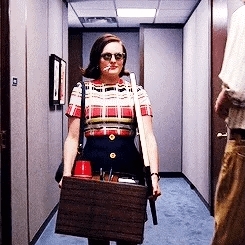“At my age, you have to play with happiness, not anguish.” - Zhiying Zeng
Hiya Friends!
I’ve been meaning to write this post for a while, but a couple of deadlines got in the way. Have you ever wondered if it’s called a deadline because as it’s looming, you feel like you might die? Just me?
Actually, I Googled the word a minute ago and it turns out I wasn’t far off.
In the 1860s, a 'dead line' was a line within or around a prison. Prisoners would be shot for crossing the 'dead line'. The sense of deadline that is most commonly found today (“a date or time before which something must be done”) did not begin to see use until the early 20th century.
Eventually, the term began to be used by journalists in the sense we know today. This was most likely the result of the design of early printing presses that featured a guideline on the printing plate. Any text inside the line would be printed. Any text outside the line — the “deadline" — would not be printed and would “die."
And that’s why not handing in your work on time is akin to being shot in a prison. Glad I could help clear that up.
IT’S NEVER TOO LATE TO BE AN OLYMPIC ATHLETE
How about these Olympics, eh? Inspiring stuff! A few weeks ago, I read about Zhiying Zeng —a 58-year-old table tennis player—who made her Olympic debut this year in Paris. Zeng was part of China’s professional youth tennis table team as a youngster until the rules were amended in 1986, and players were forced to switch to bi-colored paddles. The change (understandably) broke Zeng’s brain.
Imagine you’ve been playing this sport almost your entire life with a paddle that is only one color and suddenly, out of nowhere, the table tennis overlords decide that you have to use a paddle with different colors on each side so that your opponent can predict the spin and speed of the ball. Honestly, I know very little about table tennis except that in my day, we called it Ping Pong. Maybe this paddle update was a great development in the game. Still, I get why it threw off Zeng. I can’t even handle when my local soft-serve ice cream shop swaps out its flavors and fails to update the info on their website. I recently entered the store, giddy for soft serve, only to discover that the flavor of the day was Black Sesame. I’m not ashamed to admit that I was inconsolable.
But back to Zeng. She gave up on her table tennis dreams at age 20 and was eventually offered a job in Chile as a table-tennis coach for kids. Later, Zeng quit coaching to focus on her more lucrative home furnishings business. Believe it or not, she didn’t even have the table tennis equipment anymore. That’s how much she’d moved on. It wasn’t until she went stir crazy during the pandemic that she bought a table and played solo games to pass the time. How that worked, I’m not really sure. I’m picturing Zeng running around the table at cartoon speed and knocking a ball back and forth. It was then that Zeng remembered she kicked ass at this game. The next thing she knew, she’d won a bunch of tournaments in Chile and qualified for the Olympics at age 58! How cool is that? And while she lost her Olympic match straight away to the 46-year-old Mariana Sahakian representing Lebanon, Zeng had a sweet reunion with her former teammate from China, Ni Xia Lian at the Games. Ni Xia Lian is 61 and plays for Luxembourg. She just competed in her sixth Olympic Games! I love them both.
Argh Alert: As I was searching for a clip to share of Zeng, I noticed that her first and last names were reversed in several headlines (wtf?), and the outlets often referred to her as a Grandma. The granny moniker really chaps my hide because the implication is that 58 is SO ANCIENT, we should all be gobsmacked that this woman even has a pulse, let alone plays a competitive sport. Meanwhile, she doesn’t even have grandkids!!
Apparently Zeng says she "feels affection" when the fans give her nicknames like Auntie and Grandma. Okay, she’s a good sport, that’s a given. I just really wish journalists would cut out this agist 💩 and stop denigrating women for being older than 20.
By the way, in the screenshot below, take a look at the headlines for the oldest male Olympian, Steffen Peters. He competed in the Games and happens to be a year older than Zeng. You may have seen a video that went viral of Peters and his "Rave Horse" trotting to electronic music at the Tokyo Olympics. I quickly scanned several articles about Peters and his age is never mentioned. Not once. I couldn’t find a single headline that read, "59-Year-Old Dressage Gramps Goes For The Gold." Well, we know why.
WE’RE HERE TO HELP!
The thing is, as much as everyone loves to bust on older adults, it’s the over-50 crowd that’s spending the most coin to help stimulate the economy. In 2020, we contributed $45 trillion buckeroos to the global GDP. According to a report by AARP, this segment of the population contributes "$8.3 trillion to the U.S. economy, and creates an additional $745 billion in value through unpaid activities, such as volunteering and family caregiving."
"This age cohort is transforming markets and sparking new ideas, products and services … across our economy.” As they continue to work, "They are fueling economic growth past the traditional retirement age. They earn wages, spend more money, generate tax revenue, give back to social causes and create demand for products and services that stimulates job growth." - AARP CEO Jo Ann Jenkins
Older adults also are consumers and represent just over half of all consumer spending, according to the U.S. Consumer Expenditure Survey mid-year 2020. They generate just over half of all annual household income and spend more than those ages 18 to 49.
So, you know, maybe don’t count us out just yet.
"A WOMAN, HE SAID, COULD NOT WIN ACCEPTANCE AS PRESIDENT"

This may be old news to some of you, but I completely missed the May 11th obituary for Mary Wells Lawrence—one of the first women to start her own advertising agency and the visionary behind tons of brilliant campaigns including, "Flick Your Bic," "Trust the Midas Touch," and "I ❤️ NY".
If you don’t know Mary Wells Lawrence’s story, it’s a dazzler. It’s also especially timely right now. Born Mary Georgene Berg in Ohio, she started out writing ad copy for department stores at age 22 in NYC. Soon after, she landed a creative position at McCann-Erickson agency in 1953. This was at a time when most of the women hired at ad agencies were secretaries like Peggy Olson on Mad Men, tasked with answering phones, emptying ashtrays, and trying to avoid creeps like Pete Campbell.
Wells Lawrence, on the other hand, cranked out great advertising concepts from the get-go. Her campaigns were well-received and admired by clients and yet, she never felt valued at McCann-Erickson. In 1957, she left. By 1963, she was earning $40,000-a-year as a vice president at Doyle Dane Bernbach, and had her sights set on running her own agency. She joined Jack Tinker & Partners as a senior partner for $60,000 a year in 1964. There she and a couple of her colleagues came up with the hugely successful “Plop-plop, fizz-fizz. Oh what a relief it is!” Alka-Seltzer campaign and the Braniff Airlines campaign, which launched a fleet of fashion-colored planes staffed by a crew outfitted in natty threads.
She toured Braniff’s terminals, examined its planes and staff, and came away dismayed. The terminals “looked like a prison camp,” she said; the planes were drab “metallic or white”; flight attendants were “dressed to look like nurses.”
Then it hit her — an idea to exploit the 1960s culture of rebel freedom, eccentricity and vitality. “I saw Braniff in a wash of beautiful color,” she said
The result was a fleet of airliners, each painted from nose to tail in one of seven bright hues: ocher, orange, turquoise, beige, yellow and two other shades of blue. Interiors were decorated with Herman Miller fabrics. Terminal lounges were redesigned by Alexander Girard with art from Mexico and South America. Flight attendants were attired in Emilio Pucci fashions worn, and removed, in layers during flights, an idea called “the air strip.”
“The End of the Plain Plane,” advertisements boasted. Braniff, suddenly the airline of the youthful jet set, reported an 80 percent leap in business. (Later, when the airline switched agencies, George Lois of Lois, Holland, Callaway contributed the tagline “When you got it — flaunt it!”)
Armed with a string of award-winning and money-making campaigns, Wells Lawrence marched into her boss’ office and asked to be promoted to agency President. He told her that she could have all the job responsibilities of President and a raise, but not the title because “a woman, he said, could not win acceptance as president.” Wrong answer, dude.
“He could see that I was feeling a red rage,” she told The Times in 2012. “And he said, ‘You wouldn’t want to ruin something you built.’ And at that point I just walked out the door. It wasn’t as though I wanted to be Betty Friedan. I just wanted my own agency.”
After quitting her jive job, Wells Lawrence started her own agency with two of her colleagues, Dick Rich and Stewart Greene. Together, Wells Rich Greene created the iconic and timeless "I ❤️ NY" in collaboration with the brilliant graphic designer/illustrator Milton Glaser.
Originally meant to last only a few months, the campaign went on for years, growing into one of the most successful and imitated in history. It instilled pride in New Yorkers and brought tourism roaring back as a key industry of both the city and the state.
Wells Lawrence became the first female CEO of a Fortune 500 company. She racked up tons of honors and accolades, and she beat uterine and breast cancer. It just goes to show that if someone is standing in the way of your dream, take a different route.
Read the full obit at this gift link.
"TRY NOT TO DIE!”

Last week, my friend Dana took me to a screening of Blazing Saddles with Mel Brooks in attendance for a special Q&A. The writer/comedian/director/producer is 98 and in no hurry to sleep the big sleep. He regaled us with hilarious stories for over an hour about his epic career and all the people he’d met along the way. Every now and again he’d stop to express how much he missed the friends that had passed on, people like Gene Wilder and Richard Pryor. When someone asked him, "What’s the secret to a long life," Brooks said, “Try not to die!” Solid advice and noted. Thanks, Mel Brooks.
Okay, that’s a wrap for today. Hope everyone is keeping cool and wearing sunscreen. If you enjoyed this post, hit the ❤️ button or leave a note. I always love hearing from you.








Thanks for the uplift, HH!
I love reading your posts! I still remember my I ❤️New York Tee-shirt I bought at Hampton Beach—with my own money. I wore it for most of my entire 12th year of life! Keep writing!!!